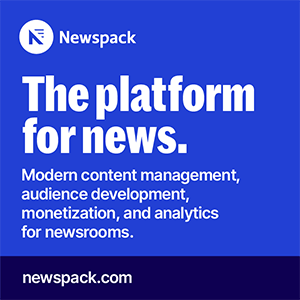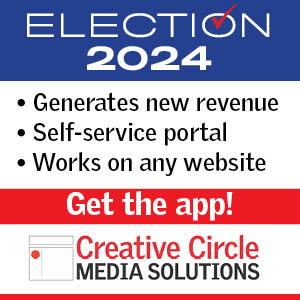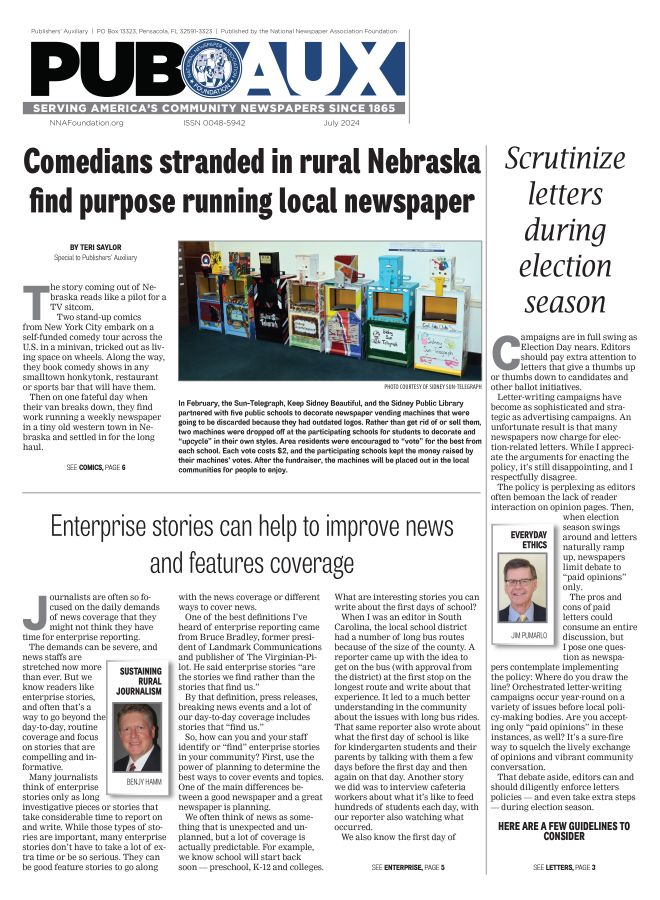Reaching beyond the local market: The Digital Challenge
Feb 1, 2013
By Stanley Schwartz
Managing Editor | Publishers' Auxiliary
Dealing with ever-increasing postal rates for out-of-county delivery has sent more than a few community newspapers searching for alternatives.
Recently the National Newspaper Association asked its members about how they handle electronic editions while attempting to slow the churn of long-distance subscribers.
Of those who answered the survey, more than half said they’re active with digital publishing—56.4 percent. Only 16 percent said they do little with their website or other digital platforms. But, this group of publishers also said they would do more as they have time and money.
The majority of those who responded to the survey, 33.3 percent, said they started their e-editions two- to five-years ago. An additional 26.9 percent said they started one within the last 12 months.
“We have our own website where people can read the paper each day and a searchable database for our abstracted records,” said Bonnie Miller of the Intermountain Commercial Record. “We are a business and legal newspaper, court and commercial records and we’re finding it difficult to get our paper out at the right time because of post office limitations and rules. … Also, the post office holds up bad addresses until they have several to notify a change—and they charge for each one.”
Deciding how to charge subscribers for an electronic version of a newspaper had some community publishing companies considering a variety of alternatives.
• 56% said they offer an e-edition available by paid subscription separate from the print newspaper.
• 13.8% said they offer their e-editions to paid print subscribers only.
• 10.3% said they offer their e-editions for free.
One publisher said, “We don’t offer an e-edition, in large part because we feel it is redundant and cumbersome in comparison to our website. We have toyed with the idea of selling PDF pages as we would photographic prints. However, our archives may drive us to revisit this issue. We’ve recently scanned all our microfilm, and if we find that some kind of PDF reader is the best archival solution … then it might make sense to investigate whether or not an e-edition would integrate well with that.”
Gary Feider of The Sounder in Random Lake, WI, said, “We began complete digital publication of our newspaper in October 2011, so that opened the door to publishing a total electronic edition using a PDF. We began doing this in January 2012 with Dirxion LLC. From 1999 through December 2011, we had a homemade website—accessible for free—that included some articles from our newspaper and other features. We still have a basic free website, which is being redesigned now. I still want to have something out there for people to access for free.”
Free or paid, ever since newspapers started putting their news on the Web, there has been a concern about not charging for the same news delivered electronically for which print subscribers have to pay. The survey asked what they decided to charge for their e-editions.
• 50.8% said they offer the e-edition at the same price and for the same terms as their print editions.
• 44.4% said they charge less for the e-editions.
• 4.8 % said they charge more.
Because subscribers who live outside a community newspaper’s county can encounter delivery delays and other problems, the survey respondents were asked if they market the e-editions to everyone or just to those long-distance subscribers.
More than 66 percent said they market the e-editions to everyone. Only 8 percent said they only market to the long-distance subscribers, though it is available to all their readers.
“Our rationale (for having an e-edition) is as an alternative to postal delivery for out-of-area customers,” said Larry Jackson, publisher of the Fayette County Record in La Grange, TX. “In-county subscribers get the print edition regardless, but can have free access to the electronic edition. The point is that we want to deliver inserts to all in-county customers.”
Postal problems were a major reason for considering e-edition distribution.
• 44.3% said postal problems influenced their decision a lot.
• 32.9% said it influenced their decision a little.
• 21.5% said the Postal Service had no influence on their decision.
Nearly 64 percent of those who answered the survey, said they had lost subscribers because of postal problems, but are currently working to get them back, using their electronic editions.
“When someone’s experiencing serious delivery problems, we offer them a free six-month online subscription; some go for it, some don’t,” said Karen Ladd, with the News and Sentinel in Colebrook, NH. “Those who don’t, tell us they like to hold the paper in their hands—it’s a piece of home to them.”
“We are targeting former subscribers with postcards, e-mails and phone calls. Our e-edition is less than a year old and growing slowly,” said Sharon DiMauro, publisher of the Fort Bragg (CA) Advocate-News.
Promotion is key to getting regular print subscribers to look at the digital version of their newspapers. Those who responded use one or more methods to increase recognition of their e-editions.
• 91% promote their e-edition in their newspaper.
• 92.3% use their websites to promote the digital version.
• 57.7% use social media.
• 10.3% use radio or TV.
Of those who answered the survey, 94.9 percent said their electronic edition was either very well or pretty well received by their readers.
“The ones that subscribe really like it,” said DiMauro. “They have access before they can pick one up locally and can read it in a variety of ways; mobile, tablet, etc.”
When asked about the future of e-editions, Chris Dickey, with the Gunnison (CO) Times, said he, “Honestly was not sure. But I think generally the popularity of our e-edition will gradually grow over time—although we’ve had one in place for nearly 10 years. We’ve never subscribed to the theory of giving our content away for free on our home web page.”
“I think it will slowly go away from print in the future—not right away—but eventually,” said Jakki Wehking, with the Parkers Prairie (MN) Independent. “We have to concentrate on the way our youth get their news and most of the time, it is by the Internet, and I can say I am probably one of those. Our older generation subscribers will be the last to change I’m sure, but change is inevitable.”
Robert S. Hackney, president and chief executive officer, for New Sheriff Publishing Co., in Sarasota, FL., said, “We believe that paper-printed media is an unsustainable model and will be virtually extinct for media within five years. Our publication was conceived to use a digital platform and, while on the cutting edge, we have had a tremendous response from the reading public, regardless of age—in fact, 45 percent of our readers are more than 55-years old.”
Archiving Newspapers
Creating digital versions of newspapers has an added benefit—the ability to archive the newspapers in fully searchable formats.
Thirty-nine percent of those who answered the survey said they have only digitally archived the last 5- to 10-years of their publications.
Some of them believe these digitally archived issues can become a revenue source in the future if more affordable options for digitizing were available—24 percent. Only 3.6 percent said it is not worthwhile to spend time or money to keep archives of digital copies.
© stan@nna.org







